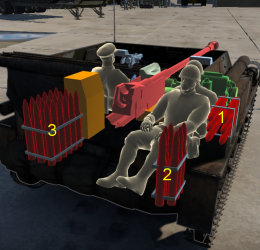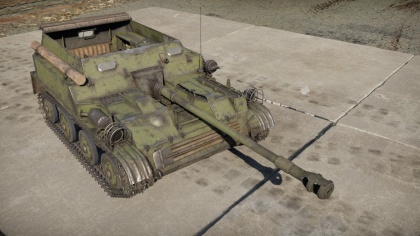Difference between revisions of "ASU-57"
(Added Historical Video) (Tag: Visual edit) |
(Fixed Youtube-Gamery Template) (Tag: Visual edit) |
||
| Line 229: | Line 229: | ||
Skin and Camouflages for the [https://live.warthunder.com/feed/camouflages/?vehicleCountry=ussr&vehicleType=tank&vehicleClass=tank_destroyer&vehicle=ussr_asu_57 ASU-57] in Warthunder Live. | Skin and Camouflages for the [https://live.warthunder.com/feed/camouflages/?vehicleCountry=ussr&vehicleType=tank&vehicleClass=tank_destroyer&vehicle=ussr_asu_57 ASU-57] in Warthunder Live. | ||
| − | {{ | + | {{Youtube-gallery}} |
== See also == | == See also == | ||
Revision as of 16:29, 1 August 2020
Contents
Description
The ASU-57 is a rank Russian tank destroyer
with a battle rating of (AB), (RB), and (SB). It was introduced in Update 1.59 "Flaming Arrows". It was designed as an airborne self-propelled gun to provide fire support and anti-tank capability for the VDV (Vozdushno-Desantnye Voyska), the Soviet airborne forces.
General info
Survivability and armour
Due to the weight restrictions necessary for air portability, the ASU-57 has nearly no armour to speak of, and the side armour can be penetrated by even rifle-calibre machine guns. It has no armoured roof, and is thus extremely vulnerable to strafing runs by aircraft.
Armour type:
- Rolled homogeneous armour
| Armour | Front (Slope angle) | Sides | Rear (Slope angle) | Roof | Belly |
|---|---|---|---|---|---|
| Body | 6 mm (21-65°) Front Plate 6 mm (38°) Lower glacis |
4 mm | 6 mm (9°) | 5 mm | 6 mm |
Notes:
- Suspension wheels are 10 mm thick, tracks are 15 mm thick
Mobility
| Game Mode | Max Speed (km/h) | Weight (tons) | Engine power (horsepower) | Power-to-weight ratio (hp/ton) | |||
|---|---|---|---|---|---|---|---|
| Forward | Reverse | Stock | Upgraded | Stock | Upgraded | ||
| Arcade | Expression error: Unexpected * operator. | 78 | Expression error: Unexpected round operator. | __.__ | |||
| Realistic | 49 | Expression error: Unexpected round operator. | __.__ | ||||
Armaments
The ASU-57 is armed with the 57 mm Ch-51M, a derivative of the 57 mm ZiS-2 anti-tank gun encountered previously on the ZiS-30. The mounting has a very limited amount of gun depression and traverse due to the small size of the ASU-57. The gun itself has a fairly fast reload, which is a good thing since it is not uncommon for the first penetrating hit to not completely destroy the target.The gun starts off with the BR-271SP APBC shot. This round has no explosive filler, but has a respectable amount of penetration and surprisingly decent post-penetration damage due to spalling. The BR-271M APCBC shell does have an explosive filler, but at the cost of lower penetration than the stock APBC round. The BR-271N APCR shot has the best penetration, but also does a pitiful amount of damage upon penetration and also performs very poorly against sloped armour.
| 57 mm ch-51M | |||||
|---|---|---|---|---|---|
| Capacity | Vertical guidance |
Horizontal guidance |
Stabilizer | ||
| 30 | -4°/+12° | ±7° | N/A | ||
| Turret rotation speed (°/s) | |||||
| Mode | Stock | Upgraded | Prior + Full crew | Prior + Expert qualif. | Prior + Ace qualif. |
| Arcade | 10.57 | 14.63 | 17.76 | 19.64 | 20.89 |
| Realistic | 7.14 | 8.4 | 10.2 | 11.28 | 12 |
| Reloading rate (seconds) | |||||
| Stock | Prior + Full crew | Prior + Expert qualif. | Prior + Ace qualif. | ||
| 6.50 | 5.75 | 5.30 | 5 | ||
Ammunition
| Penetration statistics | |||||||
|---|---|---|---|---|---|---|---|
| Ammunition | Type of warhead |
Penetration in mm @ 90° | |||||
| 10m | 100m | 500m | 1000m | 1500m | 2000m | ||
| BR-271SP | APBC | 162 | 158 | 144 | 129 | 115 | 103 |
| BR-271M | APCBC | 146 | 142 | 127 | 110 | 96 | 83 |
| O-271 | HE | 5 | 5 | 5 | 5 | 5 | 5 |
| BR-271N | APCR | 159 | 155 | 140 | 123 | 108 | 94 |
| Shell details | ||||||||||
|---|---|---|---|---|---|---|---|---|---|---|
| Ammunition | Type of warhead |
Velocity in m/s |
Projectile Mass in kg |
Fuse delay
in m: |
Fuse sensitivity
in mm: |
Explosive Mass in g (TNT equivalent): |
Normalization At 30° from horizontal: |
Ricochet: | ||
| 0% | 50% | 100% | ||||||||
| BR-271SP | APBC | 1020 | 3.4 | N/A | N/A | N/A | +4° | 48° | 63° | 71° |
| BR-271M | APCBC | 975 | 2.8 | 1.2 | 9 | 20.02 | +4° | 48° | 63° | 71° |
| O-271 | HE | 695 | 3.7 | 0.4 | 0.01 | 220 | +0° | 79° | 80° | 81° |
| BR-271N | APCR | 1125 | 2.4 | N/A | N/A | N/A | +1.5° | 66° | 70° | 72° |
Ammo racks

| Full ammo |
1st rack empty |
2nd rack empty |
3rd rack empty |
Visual discrepancy |
|---|---|---|---|---|
| 30 | 25 (+5) | 19 (+11) | 1 (+29) | No |
Right side empty: 19 (+11)
Usage in battles
One of the smallest tracked vehicles in the game, weighing only 3.3 tons, the ASU-57's complete lack of armour makes it extremely vulnerable. Its only defense is its small size, making it extremely difficult to notice, let alone hit. It accelerates quickly and is very nimble for a turretless tank destroyer.
The ASU-57 is very difficult but can be very rewarding and fun to play. It is not recommended for arcade battles, as its primary advantage, stealth, is lost. The ASU-57 is a master of stealth, famed and beloved by the community for its ability to sneak up on tanks using its extremely small size. When using the ASU-57, objects that other tanks would ignore or simply drive over are capable of completely hiding the vehicle, making ambushes and surprise attacks the specialty of the ASU-57. This size comes at a cost, however, as the ASU-57 is extremely vulnerable to almost anything that can shoot at it. Aircraft are especially dangerous due to the open crew compartment.
The ASU-57 is best used as an ambusher/flanker, executing surprise attacks from unexpected locations other vehicles would struggle or be unable to reach. The ASU-57 is incredibly short, and by driving up next to an enemy it can render the enemy tank completely helpless, as almost no vehicle has enough gun depression to reach it. For this reason, it is recommended to only go after isolated vehicles, as an enemy teammate will be able to assist their ally by destroying the ASU-57. For the maximum efficiency of this tactic, knock out the driver of the enemy vehicle, then rush up to their side before they can bring their gun to bear.
It is also interesting to note that the ASU-57 is the lowest ranked vehicle in the game with access to night vision devices.
Modules
| Tier | Mobility | Protection | Firepower | ||||
|---|---|---|---|---|---|---|---|
| I | Tracks | Parts | Horizontal Drive | ||||
| II | Suspension | Brake System | FPE | Adjustment of Fire | Airstrike | BR-271M | |
| III | Filters | Crew Replenishment | Elevation Mechanism | ||||
| IV | Transmission | Engine | Improved optics | BR-271N | NVD | ||
Pros and cons
Pros:
- Tiny size; difficult to spot and hit
- Armour is too thin to trigger APHE fuzes
- Excellent mobility
- Most powerful 57 mm gun in the game
- Lowest ranked vehicle that has access to NVDs
- Given all the abilities of a light tank (scouting, help repair)
- Very short; so most tanks can't kill it with their main gun up close
Cons:
- Virtually no armour, can be hull-broken
- Low ammunition capacity
- Extremely vulnerable to aircraft
- 57 mm gun rarely destroys vehicles with one shot
- Prone to hull break
- Poor gun depression and horizontal traverse
- NVD's are only available in 3rd person or in the Commander's view
History
Development
In mid-1940s, sometime either late in World War II or post-war, a proposal was made to develop a vehicle for the airborne troops. The vehicle was to be a lightweight assault gun able to support the paratroopers by being transportable by air. The task was given to two design bureaus, OKB-40 headed by Nikolaj Astrov in Mytischi and the other to Anatoly Karvtsev in Moscow. Astrov designed his vehicle as the ASU-76, armed with a 76 mm D-56T gun. The design ended up being too heavy and its armour way too thin for adequate protection and was cancelled. Kartsev's project was the K-73 which was amphibious and used a 57 mm Ch-51 anti-tank gun as its armament. This was even more thinly armoured than the ASU-76 and was also cancelled.
In 1949, Astrov was able to continue work on his design, but with specifications that the vehicle be made lighter and use the 57 mm Ch-51 gun instead due to its anti-tank performances. The redesigned vehicle was labeled Object 572 and passed the test phases in 1949. It was formally accepted for service as the ASU-57 in 1951 and production lasted from 1950 to 1952 with amounts produced up to a thousand.
Usage
The ASU-57, as an airborne vehicle, was made to be air-dropped from planes and land via a rocket-assisted parachute. It was then crewed by its airborne crew and support the airborne troops in their operation. Each airborne division had 54 vehicles at its disposal. It proved successful despite its weak armour and small caliber as this type of vehicle was invaluable in the hands of airborne troops, able to use a mobile artillery vehicle behind enemy lines. The ASU-57 stayed in service in the Soviet Airborne Forces for around 20 years before being replaced by the ASU-85.
The ASU-57 was also given out to the Soviet Union's allies from 1960s to 70s. Such included Egypt, East Germany, North Korea, Poland, Sahrawi Republic, Vietnam, Yugoslavia, and Ethiopia.
Historical Footage
Media
Skin and Camouflages for the ASU-57 in Warthunder Live.
See also
External links
| USSR tank destroyers | |
|---|---|
| SU-76M | SU-76M · SU-76M (5th Gv.Kav.Corps) · SU-85A |
| SU-57B | SU-57B · SU-76D |
| T-34 Derivatives | SU-122 · SU-85 · SU-85M · SU-100 · SU-122P |
| Heavy Tank Derivatives | SU-100Y · ISU-122 · ISU-122S · SU-152 · ISU-152 · Object 268 |
| SU-100P and Derivatives | SU-100P · Object 120 |
| Wheeled | YaG-10 (29-K) |
| Airborne | ASU-57 · ASU-85 |
| Rocket | BM-8-24 · BM-13N · BM-31-12 |
| ATGM | IT-1 · Shturm-S · Object 775 · Khrizantema-S |
| Artillery | 2S1 · 2S3M |
| Other | SU-5-1 · ZiS-30 · SU-122-54 |
| USA | SU-57 |





